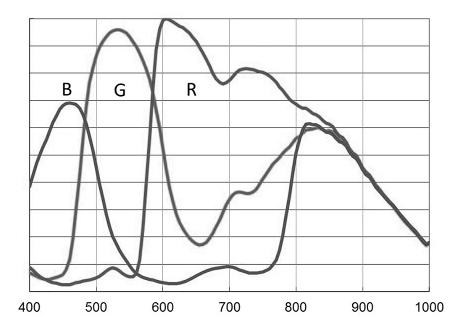- How to determine a good color balance
- OSC (One-Shot-Color) instruments
OSC (One-Shot-Color) instruments

Many modern OSC cameras have a spectrum response that increases in sensitivity across all channels beyond the visual spectrum red cut-off (the human eye can detect red wavelengths up until around 700nm). This is a feature that allows these cameras pick up detail beyond the visual spectrum (for example for use with narrowband filters or for recording infrared detail).
However, imaging with these instruments without a suitable IR/UV filter (also known as a "luminance filter") in place, will cause these extra-visual spectrum wavelengths to accumulate in the visual spectrum channels. This can significantly impact the "correct" (in terms of visual spectrum) colouring of your image. Just as a light pollution filter makes it fundamentally impossible to white-balance back the missing signal, so too does imaging with extended spectrum response make it impossible to white-balance the superfluous signal away.
Hallmarks of datasets that have been acquired with such instruments, without a suitable IR/UV filter in place, is a distinct yellow cast that is hard (impossible) to get rid of, due to a strong green response coming back in combined with extended red channel tail.
The solution is to image with a suitable IR/UV filter in place that cuts-off the extended spectrum response before those channels increase in sensitivity again. The needed IR/UV filter will vary per OSC. Consult the respective manufacturers' spectral graphs to find the correct match for your OSC.
You may also be interested in...
- Launching the Color module (under Usage)
If a full mask is not set, the Color modules allows you to set it now, as colour balancing is typically applied to the full image (requiring a full mask).
- On synthetic luminance generation (under Usage)
Any narrowband accent data loaded, does not impact synthetic luminance generation.
- Tweaking your colors (under Usage)
Luminance retention in CIELab color space is applied afterwards.
- Color retention (under Usage)
The two aspects - colour and luminance - of your image are neatly separated thanks to StarTools' signal evolution Tracking engine.
- Popular coloring (under Usage)
A popular bi-color rendition of H-alpha and O-III is to import H-alpha as red and O-III as green as well as blue.
